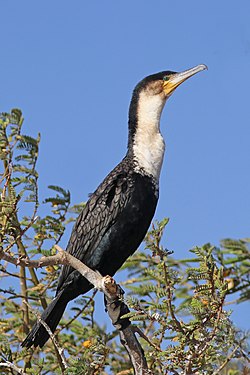| White-breasted cormorant | |
|---|---|
 | |
| Lake Ziway, Ethiopia | |
| Scientific classification | |
| Domain: | Eukaryota |
| Kingdom: | Animalia |
| Phylum: | Chordata |
| Class: | Aves |
| Order: | Suliformes |
| Family: | Phalacrocoracidae |
| Genus: | Phalacrocorax |
| Species: | |
| Subspecies: | P. c. lucidus |
| Trinomial name | |
| Phalacrocorax carbo lucidus (Lichtenstein, MHC, 1823) | |
 | |
| Range, excluding isolated northern and western populations [1] breeding range non-breeding range | |
| Synonyms | |
Phalacrocorax carbo lucidus | |
The white-breasted cormorant (Phalacrocorax carbo lucidus) is a subspecies of the widely distributed great cormorant, formerly often considered to be a separate species. Its distinguishing features include a white breast and a preference for freshwater habitats among its subpopulations. [2] The species should not be confused with the smaller and morphologically distinct endemic South Australian black-faced cormorant, which occasionally shares the common name "white-breasted cormorant".




